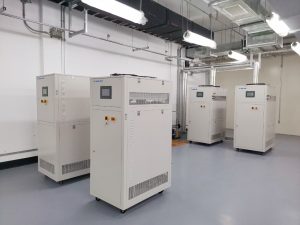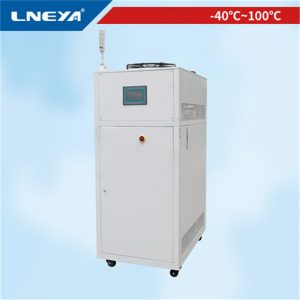Technological Characteristics of Glycol Refrigeration System
At present, it is often necessary to provide process chilled water of 1-4℃ for the production line in the milk, beverage and other industries. Because the temperature of frozen water in 1-4℃ process is close to the freezing point of water at 0℃, it is easy to freeze, which is very dangerous. First, it will destroy the evaporator. Second, it can not timely reduce the temperature of frozen water to required temperature of 1-4℃ for production because of the influence of the evaporator freezing to affect heat transfer.
At present, there are two common ways to produce chilled water ar the temperature of 1-4℃: A. The system with ammonia as refrigerant and open steel tube as evaporator is adopted. B. The system with freon as the refrigeration liquid and glycol refrigerant system as cooling carrier is shell-and-tube heat exchanger as heat exchange equipment Freon refrigeration system, which is also known as
glycol refrigeration system. According to the actual application, the ammonia refrigeration system of Plan A adopts open steel tube as evaporator, and the cooling capacity of ammonia is transferred to the chilled water through the evaporator. In this process, the flow velocity is too small. Even if the agitator is installed, the speed of the chilled water is difficult to control and the distribution is very uneven, so the surface of the open steel tube evaporator is often frozen and the water temperature is difficult to drop to the design value. At the same time, the steel tube evaporator after a long time of use was corroded by frozen water, happening the leaking phenomenon. Because of the ice on the surface of the open steel tube, although the open steel tube evaporator will not be destroyed, the cooling capacity of ammonia can not be transferred to the chilled water in time, which will lead to the unloading and shutdown of the compressor or even alarm after a long time. The more serious cases is that hydraulic compression will destroy the compressor, which can not meet the production needs. Plan B uses Freon as refrigerant and ethylene glycol as refrigerant to increase shell-and-tube heat exchanger. During installation, glycol goes through shelling process and frozen water goes through the pipeline process. Because the water system uses circulating pump to force heat transfer, and the frozen water goes through the pipe, the frozen water is fast, stable and has no dead angle, which can prevent the phenomenon of icing. On the other hand, due to the addition of refrigerant, the evaporation temperature of Freon is lower than below 10 C, so the energy efficiency ratio of this refrigeration system is relatively low, but it can produce 1 – 2 ℃ chilled water. Therefore, this scheme is suitable for the occasion where 1-2 ℃ chilled water is needed.
In recent decades, Freon R22 chiller has developed rapidly. Because of its shell-and-tube dry evaporator, the outlet temperature of chilled water is generally 7 ℃ and the lowest is 5 ℃ which does not meet the requirements of process chilled water of the 1-4 ℃. However, due to the above problems in ammonia refrigeration system, and the problems of ammonia flammability, explosion, toxicity and leakage, more and more customers reconsider the use of Freon to directly produce frozen water.
 LNEYA Industrial Chillers Manufacturer Supplier
LNEYA Industrial Chillers Manufacturer Supplier













